| Listing 1 - 10 of 22 | << page >> |
Sort by
|
Book
ISBN: 9780323972062 0323972063 9780323918022 0323918026 Year: 2023 Publisher: London, England ; San Diego, California : Academic Press,
Abstract | Keywords | Export | Availability | Bookmark
 Loading...
Loading...Choose an application
- Reference Manager
- EndNote
- RefWorks (Direct export to RefWorks)
Inflammasome Biology: Fundamentals, Role in Disease States, and Therapeutic Opportunities is a complete reference on the role of inflammasomes in health and disease. Sections cover the different types of inflammasomes, including cellular signaling, structural and evolutive aspects, overview the role of inflammasomes in key diseases, microbial infections and human body systems conditions, cover the interplay between Inflammasomes and cell death processes, and discuss current therapeutic opportunities driven by inflammasome research, including targeting, blocking and inhibiting the development of inflammasomes through both synthetic and natural compounds.
Inflammation --- Immunological aspects. --- Mediators. --- Inflammatory mediators --- Mediators of inflammation --- Biomolecules --- Immunology of inflammation --- Immune response --- Immunology --- Inflammation Mediators
Book
ISBN: 3034808372 3034808364 1322038252 Year: 2014 Publisher: Basel : Springer Basel : Imprint: Springer,
Abstract | Keywords | Export | Availability | Bookmark
 Loading...
Loading...Choose an application
- Reference Manager
- EndNote
- RefWorks (Direct export to RefWorks)
This volume examines in detail the role of chronic inflammatory processes in the development of several types of cancer. Leading experts describe the latest results of molecular and cellular research on infection, cancer-related inflammation, and tumorigenesis. Further, the clinical significance of these findings in preventing cancer progression and approaches to treating the diseases are discussed. Individual chapters cover cancer of the lung, colon, breast, brain, head and neck, pancreas, prostate, bladder, kidney, liver, cervix, and skin as well as gastric cancer, sarcoma, lymphoma, leukemia, and multiple myeloma.
Cancer --- Inflammation --- Immunological aspects. --- Mediators. --- Inflammatory mediators --- Mediators of inflammation --- Biomolecules --- Carcinogenesis --- Immunological aspects --- Oncology. --- Immunology. --- Oncology . --- Cancer Research. --- Tumors --- Immunobiology --- Life sciences --- Serology --- Cancer research. --- Cancer research
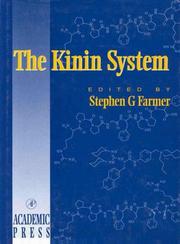
ISBN: 9780122493409 0122493400 9780080542522 0080542522 128105903X 9781281059031 9786611059033 Year: 1997 Publisher: San Diego, California : Academic Press,
Abstract | Keywords | Export | Availability | Bookmark
 Loading...
Loading...Choose an application
- Reference Manager
- EndNote
- RefWorks (Direct export to RefWorks)
Bradykinin is a type of plasma hormone that causes blood vessels to dilate, resulting in a drop in blood pressure, the contraction of muscles in the lungs, intestines, and uterus, and pain. The Kinin System reviews the molecular biology of the kinins through their roles in a complex array of inflammatory conditions such as asthma, GI disease, cardiovascular complaints and examines the future therapeutic opportunities. The Kinin System is a comprehensive, timely book covering all aspects of the kinin system from its disocvery to the pathophysiology, pharmacology, and molecular biolog
Pathology --- Kinins --- Inflammation --- Immunopharmacology. --- Pharmacoimmunology --- Immunology --- Pharmacology --- Immunotoxicology --- Inflammatory mediators --- Mediators of inflammation --- Biomolecules --- Hypotensive agents --- Polypeptides --- Vasodilators --- Physiological effect. --- Pathophysiology. --- Mediators. --- Mediators
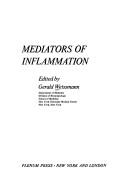
ISBN: 0306308150 1468407473 1468407457 Year: 1974 Publisher: New York (N.Y.): Plenum
Abstract | Keywords | Export | Availability | Bookmark
 Loading...
Loading...Choose an application
- Reference Manager
- EndNote
- RefWorks (Direct export to RefWorks)
Inflammation. --- Inflammation --- Inflammation (Pathologie) --- Mediators. --- Médiateurs --- -Inflammatory process --- Pathology --- Anti-inflammatory agents --- Inflammations --- Mediators --- -Mediators --- -Inflammations --- Inflammatory process --- Médiateurs --- Inflammatory mediators --- Mediators of inflammation --- Biomolecules --- Innate Inflammatory Response --- Inflammatory Response, Innate --- Innate Inflammatory Responses --- Immunity, Innate
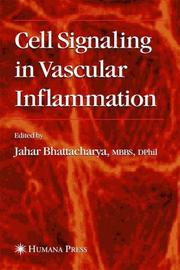
ISBN: 1280359161 9786610359165 1592599095 1588295257 1617376191 Year: 2005 Publisher: Totowa, N.J. : Humana Press,
Abstract | Keywords | Export | Availability | Bookmark
 Loading...
Loading...Choose an application
- Reference Manager
- EndNote
- RefWorks (Direct export to RefWorks)
Although inflammatory disease of the vascular bed of the lung is a major cause of morbidity and mortality in both adult and pediatric age groups, the importance of vascular biology to its understanding, and in developing novel therapeutics, has been overlooked. In Cell Signaling in Vascular Inflammation, leading basic and clinical researchers review the signal transduction mechanisms responsible for lung inflammation, including vascular hyperpermeability, white cell accumulation, and vascular remodeling. The authors cut across disciplines to bring together a broad-based presentation of inflammatory challenge, both in the initial phases of the inflammatory response, as well as in the more prolonged phase of genomic involvement. Authoritative and state-of-the-art, Cell Signaling in Vascular Inflammation offers physiologists, molecular and cell biologists, and pharmaceutical scientists a comprehensive survey of the signal transduction pathways in lung vascular cells that illuminates not only the processes of lung inflammation, but also the potential for developing new therapeutic strategies to combat inflammatory lung disease.
Vasculitis. --- Cellular signal transduction. --- Inflammation --- Mediators. --- Medicine. --- Vascular surgery. --- Medicine & Public Health. --- Vascular Surgery. --- Vascular surgery --- Clinical sciences --- Medical profession --- Human biology --- Life sciences --- Medical sciences --- Pathology --- Physicians --- Inflammatory mediators --- Mediators of inflammation --- Biomolecules --- Cellular information transduction --- Information transduction, Cellular --- Signal transduction, Cellular --- Bioenergetics --- Cellular control mechanisms --- Information theory in biology --- Angiitis --- Blood-vessels --- Vasculitides --- Diseases --- Surgery.
Periodical
ISSN: 1179139X Year: 2009 Publisher: Auckland, NZ Dove Medical Press
Abstract | Keywords | Export | Availability | Bookmark
 Loading...
Loading...Choose an application
- Reference Manager
- EndNote
- RefWorks (Direct export to RefWorks)
Interferon --- Cytokines --- Interférons --- Periodicals --- Périodiques --- Inflammation --- Interferons. --- Cytokines. --- Inflammation Mediators. --- Interferon. --- Mediators --- Mediators. --- Interferons --- Inflammatory mediators --- Mediators of inflammation --- Mediators of Inflammation --- Mediators, Inflammation --- Inflammatory process --- Antineoplastic agents --- Antiviral agents --- Glycoproteins --- Lymphokines --- Biomolecules --- Cellular immunity --- Immune response --- Inflammasomes --- Viral Interference --- Pathology --- Anti-inflammatory agents --- Regulation --- interferon --- Microbiology & Immunology --- Cytokine --- Interferó. --- Citocines. --- Inflammation Mediators --- Inflammation (Pathologie) --- Médiateurs
Book
ISBN: 3030563197 3030563189 Year: 2021 Publisher: Cham, Switzerland : Springer,
Abstract | Keywords | Export | Availability | Bookmark
 Loading...
Loading...Choose an application
- Reference Manager
- EndNote
- RefWorks (Direct export to RefWorks)
TLR4 is one of the most important innate immunity receptors, its function mainly consisting in the activation of inflammatory pathways in response to stimulation by Pathogen-Associated Molecular Patterns (PAMPs) and Damage Associated Molecular Pattern molecules (DAMPs). This volume critically reviews the different types of TLR4 activators and inhibitors, discusses the role of molecular aggregates in agonism/antagonism as well as the pivotal role of the CD14 receptor in the modulation of TLR4 signal and the molecular details and actors of the intracellular cascade. The book presents the role of TLR4 in several pathologies, such as sepsis and septic shock caused by receptor activation by gram-negative bacterial lipopolysaccharide (LPS), in neurodegenerative and neurological diseases such as Parkinson and Alzheimer’s diseases, and Amyotrophic Lateral Sclerosis (ALS). It reviews the role of TLR4 in neural stem cell-mediated neurogenesis and neuroinflammation and in Human Induced Pluripotent Stem Cells and Cerebral Organoids and discusses the emerging role of micro-RNA (miRNA) regulation by TLR4. .
Proteins . --- Immunology. --- Medical microbiology. --- Infectious diseases. --- Cancer research. --- Receptors. --- Medical Microbiology. --- Infectious Diseases. --- Cancer Research. --- Cancer research --- Immunobiology --- Life sciences --- Serology --- Proteids --- Biomolecules --- Polypeptides --- Proteomics --- Inflammation --- Cell receptors. --- Mediators. --- Immunological aspects. --- Cell membrane receptors --- Cell surface receptors --- Receptors, Cell --- Binding sites (Biochemistry) --- Cell membranes --- Proteins --- Immunology of inflammation --- Immune response --- Inflammatory mediators --- Mediators of inflammation --- Immunology
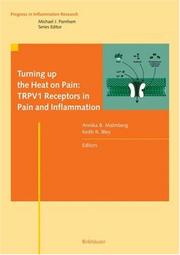
ISBN: 1280413468 9786610413461 3764373792 3764370807 Year: 2005 Publisher: Basel ; Boston : Birkhauser Verlag,
Abstract | Keywords | Export | Availability | Bookmark
 Loading...
Loading...Choose an application
- Reference Manager
- EndNote
- RefWorks (Direct export to RefWorks)
Despite tremendous advances in the understanding of the sensory nervous system which have accompanied the recent explosive growth of the neurosciences, rema- ably few innovative medicines directed towards pain and inflammation are ava- able. Indeed, many patients are still prescribed analgesic and anti-inflammatory medications that were identified long ago as components of herbal remedies. Si- larly, potential new medicines in clinical evaluation based on capsaicin and the c- saicin receptor are both grounded firmly on folk traditions and yet rely upon the most contemporary techniques of drug discovery and delivery. The first formal report of the pain-relieving properties of capsaicin appeared in 1850 [1]. However, for centuries before this, capsaicin-containing extracts had been used as folk medicines in cultures with access to pepper plants, much in the same way as poppy or willow-bark extracts were. Despite widespread use, it was not until 1878 that the selective action of capsaicin on the sensory nervous system was r- ognized [2]. In Chapter 1 of this volume, Janos Szolcsányi reviews this early research, which culminated with the seminal studies of Nicholas Jansco and his c- leagues in Hungary in the 1940s. Since then, capsaicin and related vanilloid c- pounds have played a prominent role in analgesia and inflammation investigations because of their ability to selectively activate a subpopulation of sensory neurons and produce sensations of pain and localized erythema.
Nociceptors. --- Pain. --- Inflammation. --- Inflammation --- Mediators. --- Inflammatory mediators --- Mediators of inflammation --- Biomolecules --- Inflammatory process --- Pathology --- Anti-inflammatory agents --- Aches --- Emotions --- Pleasure --- Senses and sensation --- Symptoms --- Analgesia --- Suffering --- Pain receptors --- Sensory receptors --- Pain Medicine. --- Immunology. --- Neurosciences. --- Toxicology. --- Cytology. --- Pharmacology/Toxicology. --- Cell Biology. --- Cell biology --- Cellular biology --- Biology --- Cells --- Cytologists --- Chemicals --- Medicine --- Pharmacology --- Poisoning --- Poisons --- Neural sciences --- Neurological sciences --- Neuroscience --- Medical sciences --- Nervous system --- Immunobiology --- Life sciences --- Serology --- Toxicology --- Algiatry --- Pain medicine. --- Pharmacology. --- Cell biology. --- Drug effects --- Medical pharmacology --- Chemotherapy --- Drugs --- Pharmacy --- Physiological effect
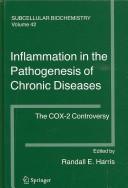
ISBN: 1280865318 9786610865314 1402056885 1402056877 9048174295 Year: 2007 Publisher: New York : Springer,
Abstract | Keywords | Export | Availability | Bookmark
 Loading...
Loading...Choose an application
- Reference Manager
- EndNote
- RefWorks (Direct export to RefWorks)
Discusses the role of inflammation in the pathogenesis of major chronic diseases and the controversy regarding risk versus benefit of selective cyclooxygenase-2 (COX-2) inhibitors. This volume is intended for scientists in medicine, epidemiology, pharmacology, molecular biology, and related fields.
Cyclooxygenase 2 --- Nonsteroidal anti-inflammatory agents. --- Inflammation --- Inhibitors. --- Mediators. --- Inflammatory mediators --- Mediators of inflammation --- Biomolecules --- Non-steroid anti-inflammatory agents --- Non-steroidal anti-inflammatory agents --- NSAIDs (Pharmacology) --- Anti-inflammatory agents --- Toxicology. --- Oncology. --- Pathology. --- Cardiology. --- Neurology. --- Immunology. --- Pharmacology/Toxicology. --- Cancer Research. --- Immunobiology --- Life sciences --- Serology --- Medicine --- Nervous system --- Neuropsychiatry --- Heart --- Internal medicine --- Disease (Pathology) --- Medical sciences --- Diseases --- Medicine, Preventive --- Tumors --- Chemicals --- Pharmacology --- Poisoning --- Poisons --- Toxicology --- Pharmacology. --- Cancer research. --- Neurology . --- Drug effects --- Medical pharmacology --- Chemotherapy --- Drugs --- Pharmacy --- Cancer research --- Physiological effect
Book
ISBN: 1281876577 9786611876579 3764376503 3764376260 Year: 2008 Publisher: Basel : Birkhäuser Basel : Imprint: Birkhäuser,
Abstract | Keywords | Export | Availability | Bookmark
 Loading...
Loading...Choose an application
- Reference Manager
- EndNote
- RefWorks (Direct export to RefWorks)
Angiogenesis is an essential component of inflammation and its resolution. This volume provides up-to-date information on the latest developments in the pathology, mechanisms and therapy of angiogenesis dependent inflammatory disease. Recent years have seen large advances in angiogenesis research, especially in oncology. Traditionally mechanisms in inflammation angiogenesis were inferred from tumour angiogenesis, however recent research has matured highlighting the similarities and dissimilarities between these processes. This volume relates the lessons learned from tumour biology applied to inflammation. This issue of Angiogenesis in Inflammation: Mechanisms and Clinical Correlates develops current knowledge on the mechanisms at the molecular and cellular levels as they relate to inflammation, including acute and chronic inflammation, neurogenic initiation, and the role of the multiple cellular components that comprise inflammation: granulocytes, macrophages, fibroblasts, dendritic cells and lymphocytes. This is related to inflammatory disease: not only the familiar angiogenesis dependent diseases of rheumatoid arthritis and psoriasis, but also loci such as the lung, gastric ulcers, the eye with uveitis, wound healing and periodontal disease and their therapy, how this knowledge may be used in the discovery of novel therapeutics. The volume brings together experts in each of these fields to link the molecular and cellular processes in angiogenesis to those of inflammation and disease, culminating in a discourse on areas for future therapies.
Neovascularization. --- Inflammation --- Mediators. --- Inflammatory mediators --- Mediators of inflammation --- Biomolecules --- Angiogenesis --- Blood-vessels --- Growth --- Immunology. --- Oncology. --- Internal medicine. --- Angiography. --- Cytology. --- Cancer Research. --- Internal Medicine. --- Angiology. --- Cell Biology. --- Cell biology --- Cellular biology --- Biology --- Cells --- Cytologists --- Diagnosis, Radioscopic --- Radiography, Medical --- Medicine, Internal --- Medicine --- Tumors --- Immunobiology --- Life sciences --- Serology --- Radiography --- Cancer research. --- Cell biology. --- Cancer research --- Cancer. --- Cancer Biology. --- Diseases. --- Angiology --- Vascular diseases --- Cancers --- Carcinoma --- Malignancy (Cancer) --- Malignant tumors
| Listing 1 - 10 of 22 | << page >> |
Sort by
|

 Search
Search Feedback
Feedback About UniCat
About UniCat  Help
Help News
News